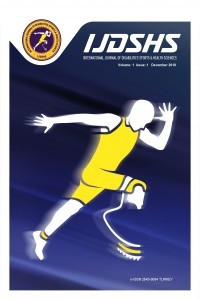Relationship of Obsessive Compulsive Disorder with Social Anxiety and Psychological Resilience in Adults
Relationship of Obsessive Compulsive Disorder with Social Anxiety and Psychological Resilience in Adults
obsessive compulsive, social anxiety, pyschological resilience,
___
- Abay, E., Pulular, A., Memiş, Ç. Ö., & Süt, N. (2010).The epidemiology of obsessive-compulsive disorder in high school students in Edirne city center. Thinking Man Journal of Psychiatry and Neurological Sciences, 23(4), 230-237.
- Agaibi, C. E., & Wilson, J. P. (2005). Trauma, PTSD, and resilience: A review of the literature. Trauma, Violence, & Abuse, 6(3), 195-216.
- Aydemir, Ö., & Köroğlu, E. (2000). Clinical scales used in psychiatry. Physicians Publications Association, Ankara, 5.
- Aydemir, Y., Doğu, Ö., Amasya, A., Yazgan, B., Gazioğlu, E. Ö., & Gündüz, H. (2015). Evaluation of anxiety and depression prevalence and related features in chronic respiratory and cardiac diseases. Sakarya Medical Journal, 5(4), 199-203.
- Basim, H. N., & Çetin, F. (2011). Reliability and validity study of the resilience scale for adults. Turkish Journal of Psychiatry,22(2), 104-114.
- Budak, S. (2005). Dictionary of Psychology. Science and Art; 17
- Büyüköztürk, Ş., Kılıç-Çakmak, E., Akgün, Ö., Karadeniz, Ş., & Demirel, F. (2008). Scientific Research Methods.
- Chamberlain, S. R., Fineberg, N. A., Blackwell, A. D., Robbins, T. W., & Sahakian, B. J. (2006). Motor inhibition and cognitive flexibility in obsessive-compulsive disorder and trichotillomania. American Journal of Psychiatry, 163(7), 1282-1284.
- Çölgeçen, Y., & Çölgeçen, H. (2020). Evaluation of Anxiety Levels Due to Covid-19 Pandemic: The Case of Turkey. Electronic Turkish Studies,15(4).
- Dajani, D. R., & Uddin, L. Q. (2015). Demystifying cognitive flexibility: Implications for clinical and developmental neuroscience. Trends in neurosciences, 38(9), 571-578.
- Derin, S., & Yorulmaz, O. (2020). Cognitive Bias Change in Obsessive Compulsive Disorder. Current Approaches in Psychiatry, 12(3), 299-317.
- Doron, G., Derby, D. S., & Szepsenwol, O. (2014). Relationship obsessive compulsive disorder (ROCD): A conceptual framework. Journal of Obsessive-Compulsive and Related Disorders, 3(2), 169-180.
- Eminağaoğlu, N. (2006). Resilience in street children living in difficult conditions (Unpublished doctoral dissertation). Ege University/Social Sciences Institute, İzmir.
- Fletcher, D., & Sarkar, M. (2013). Psychological resilience. European psychologist.
- Gabrys, R. L., Tabri, N., Anisman, H., & Matheson, K. (2018). Cognitive control and flexibility in the context of stress and depressive symptoms: The cognitive control and flexibility questionnaire. Frontiers in Psychology, 9, 2219.
- Hallion, L. S., Ruscio, A. M., & Jha, A. P. (2014). Fractionating the role of executive control in control over worry: A preliminary investigation. Behaviour Research and Therapy, 54, 1-6.
- Huang, W. L., Chen, T. T., Chen, I. M., Ma, H. M., Lee, M. T., Liao, S. C., & Gau, S. F. (2016). Depression and anxiety among patients with somatoform disorders, panic disorder, and other depressive/anxiety disorders in Taiwan. Psychiatry Research, 241, 165-171.
- Leipold, B., & Greve, W. (2009). Resilience: A conceptual bridge between coping and development. European Psychologist, 14(1), 40-50.
- Lewis, K. M., Byrd, D. A., & Ollendick, T. H. (2012). Anxiety symptoms in African-American and Caucasian youth: Relations to negative life events, social support, and coping. Journal of Anxiety disorders, 26(1), 32-39.
- Lewis, K. M., Byrd, D. A., & Ollendick, T. H. (2012). Anxiety symptoms in African-American and Caucasian youth: Relations to negative life events, social support, and coping. Journal of Anxiety disorders, 26(1), 32-39.
- Masten, A. S. (2001). Ordinary magic: Resilience processes in development. American psychologist, 56(3), 227. Ohayon, M. M., & Schatzberg, A. F. (2010). Social phobia and depression: prevalence and comorbidity. Journal of psychosomatic research, 68(3), 235-243.
- Parlak, S. (2014). The relationship between life meaning levels and psychological resilience of female students in the Higher Education Credit and Hostels Institution (Istanbul example). Marmara University, İstanbul
- Piryaei, S., & Khademi, M. (2014). EPA-1137–The moderating role of metacognition in relationship of perceived job stress and negative affect. European Psychiatry, 29(S1), 1-1.
- Silverstone, P. H., & Salsali, M. (2003). Low self-esteem and psychiatric patients: Part I–The relationship between low self-esteem and psychiatric diagnosis. Annals of general hospital psychiatry, 2(1), 1-9.
- Swedo, S. (2006). The Neurobiology and Treatment of Obsessive–Compulsive-Disorder. Neurobiology Of Mental Illness. DS Charney.
- Tekbıyık, A. (2014). Relational research method. M. Metin (Edt.) Scientific research methods in education from theory to practice, 99, 114
- Yayın Aralığı: Yılda 3 Sayı
- Başlangıç: 2018
- Yayıncı: Nevzat DEMİRCİ
Hale Havva KAĞANSOY KOCAİSMAİL, Yasemin SORAKIN
Development of the Workplace Work Environment Ergonomics Scale for Nurses
Ali AĞAR, Soner BERŞE, Ezgi DİRGAR
Halil İbrahim BULGUROĞLU, Merve BULGUROĞLU, Cansu GEVREK, Serenay ZORLU, Sezen DİNCER, Kübra KENDAL
Determination of Anthropometric Measurements and Nutritional Status of Wheelchair Basketball Players
Ayşe Hümeyra İSLAMOĞLU, Esra ÖNDAR, Tuğçe YILDIRIM, Zehra KARTAL
Tezel YILDIRIM ŞAHAN, Duygu TÜRKER, Büşra Nur AKSU, Melike ÖZCAN, Elif YAVAŞ, Seda BİCİCİ ULUŞAHİN
Sebelasmaret Boccia Throw Test (SBTT) Instrument Development
Satria Yudi GONTARA, Rumi DOEWES
Mohan Kumar PASUPULETİ, Divya Naga Lakshmi P, Jyothirmai KONERU, Swathi P, Karteek Varma PV, Sai Amulya KUKUTLA
Nayan KADAV, Radha BHENDE, Sandeep SHİNDE
Caregiving Children with Visually Impairments: Occupational Balance and Quality of Life Perspective
Güleser GÜNEY YILMAZ, Hatice ABAOĞLU, Tarık DEMİROK, Esra AKI
